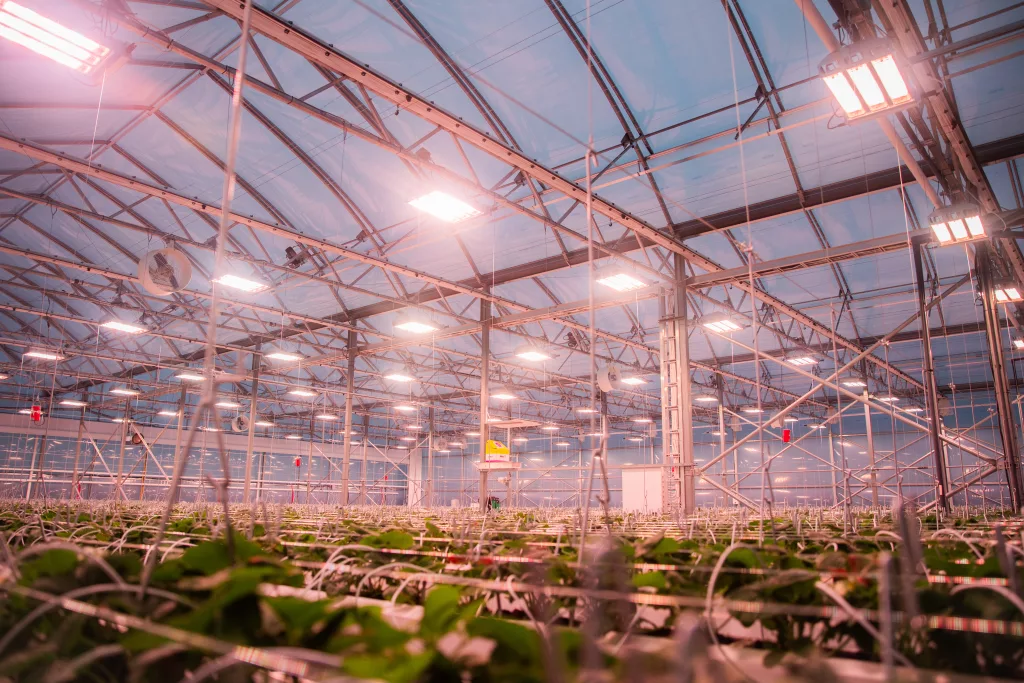In today’s evolving agricultural landscape, the demand for high-efficiency, sustainable growing systems has never been greater. Producers of small fruits—such as strawberries, raspberries, and blackberries—are seeking innovative methods of growing strawberries in a greenhouse to improve yield, crop quality, and labor efficiency. One transformative solution leading this revolution is the small fruits greenhouse equipped with elevated bench growing systems.
Growing strawberries in a greenhouse offers a future-forward approach to commercial production. This system not only maximizes production potential but also addresses modern challenges like climate variability, soil-borne diseases, and rising labor costs.

The Power of a Small Fruits Greenhouse
Unlike traditional open-field farming or basic high tunnel systems, a modern small fruits greenhouse provides a fully controlled environment where temperature, humidity, lighting, and CO₂ levels are optimized year-round. This controlled setting is particularly beneficial for delicate crops like strawberries, blueberries, and cane fruits that are sensitive to climate changes.
Growing strawberries in a greenhousecan be outfitted with hydroponic or soilless systems, LED lighting, and climate automation technologies that support high-density, high-quality production. By maintaining optimal growing conditions every day of the year, growers can avoid seasonal dips in productivity and meet consistent market demand.
Why Elevated Bench Systems Are Game-Changing
Elevated bench systems bring growing strawberries in a greenhouse to new heights—literally. Instead of planting directly in the ground or on floor-level substrates, crops are cultivated on raised platforms or gutters. This method offers several major benefits:
1. Better Disease and Pest Management
Raising plants off the ground drastically reduces exposure to soilborne pathogens and pests. It also improves air circulation around the plants, lowering humidity levels and the risk of fungal diseases like powdery mildew and botrytis.
2. Improved Harvesting Efficiency
Benches position plants at an ergonomic height, which makes picking significantly easier and faster. Laborers can harvest more quickly and with less physical strain, which reduces labor costs and increases picking accuracy—vital for delicate fruits.
3. Maximized Use of Space
Growing strawberries in a greenhouse with benches can utilize vertical space, making room for multiple layers of production. Narrower aisles and precise bench spacing mean more plants per square foot without compromising accessibility or airflow.
4. Precision Irrigation and Fertilization
Bench systems often incorporate drip irrigation or hydroponic setups, giving growers full control over the nutrient mix and water supply. This reduces waste, saves water, and ensures optimal plant nutrition throughout the crop cycle.
Types of Structures: Choosing the Right Greenhouse
There are two main types of greenhouse structures suitable for small fruit production:
1. Glass Greenhouses
These are ideal for regions with cold climates, offering excellent light transmission and a long lifespan. While they require higher upfront investment, their durability and year-round performance make them a solid choice for long-term operations.
2. Gutter-Connected Poly Greenhouses
These gutter-connected structures are more cost-effective and modular, allowing growers to scale their operations over time. They are well-suited to automation systems for shading, cooling, and fertigation, and work exceptionally well with elevated benches.
3. Freestanding Greenhouses
Freestanding greenhouses are standalone structures not connected to others by gutters. They are typically easier to install, flexible in placement, and great for small- to mid-scale operations. Their independent design allows for easier climate zoning and crop separation, making them ideal for diversified small fruits production.
4. High PolyTunnel Greenhouses
High polytunnels are arched, semi-permanent structures covered with polyethylene film. They offer an affordable entry point into protected small fruits cultivation and are ideal for seasonal or early/late season production. While not as insulated as glass or poly greenhouses, they provide sufficient protection from wind, rain, and pests, and can be adapted with roll-up sides for ventilation.
Cost and Investment Overview
Growing strawberries in a greenhouse with elevated bench systems requires thoughtful planning and capital investment. For a one-acre setup, the cost can vary depending on the greenhouse type and technology level:
- Gutter-connected poly greenhouse structure: Approx. $12 per sq. ft.
- Elevated bench and hydroponic system: $10–$20 per sq. ft.
- Climate and lighting automation: $500,000–$1,000,000 per acre
- Annual operating costs: $250,000–$400,000 per acre
Though the upfront costs may seem significant, the long-term return on investment is promising. Higher yields, better fruit quality, lower water and pesticide usage, and labor efficiencies all contribute to profitability.
Projected Returns and Yield Potential
Growers growing strawberries in a greenhouse can expect:
- Annual yield: 50,000–80,000 lbs per acre for strawberries; slightly less for other berries depending on the variety
- Price per pound:
- Wholesale: $3–$6
- Direct-to-consumer: $6–$10
- Gross annual revenue: $300,000–$800,000 per acre
- Break-even point: 4–8 years, depending on market conditions and operational costs
The ability to produce consistently, independent of outdoor climate conditions, also opens up premium retail opportunities and contracts with grocers who require stable year-round supply.
Sustainability Benefits
Today’s consumers and retailers care about sustainability—and so should producers. A small fruits greenhouse with a bench system checks multiple boxes:
- Reduced water usage: Hydroponic drip systems can cut water usage by up to 90%
- Fewer chemicals: Soilless and elevated systems mean fewer diseases and pests, reducing pesticide use
- Local production: Greenhouses close to markets shorten supply chains and reduce emissions
- Energy efficiency: Modern greenhouses utilize energy curtains, LED lighting, and heat recycling for minimal energy waste
Who Should Consider This Approach?
This system is ideal for:
- Established berry growers looking to extend their growing season or add premium products
- New entrants wanting to avoid the risks of open-field farming
- Retailers or co-ops looking to vertically integrate and produce their own fresh fruit
- Urban agriculture initiatives aiming for high-value crops in limited space
Final Thoughts
As consumer demand for fresh, local produce continues to rise, greenhouse-based fruit production is stepping into the spotlight. The small fruits greenhouse with elevated bench growing systems is more than a trend—it’s a strategic investment for growers seeking resilience, quality, and profitability.
By integrating modern technology, ergonomic design, and sustainable practices, this model redefines what’s possible for berry producers around the world.
